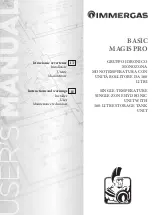
CONTROL METHODS
HeatNet Control V3
Page 23
(1) Degree F of hysteresis is provided so as to not
toggle offline<-to->online at the threshold temp.
Since the FIII boiler is non-condensing, the efficiency vs.
input is relatively flat. The MOD MAX value will not have
the same impact if the FIII non-condensing boilers were
placed in the Priority 1 set.
In a mixed condensing/non-condensing boiler system
example: (2) CK 1500s are set as Priority 1 and (3)
MB/MW 2500s are set as Priority 2. With a MOD MAX of
60%, each CK 1500 can run to 900M (1800M total) before a
MB/MW 2500 is called ON (Add Delay timer). Once both
CK 1500s are running and the CK 2500 is called on, all (3)
boilers will drop to a total of the 1800M BTUs. Taking this
1800M value and dividing by total M BTUS of the (3)
boilers, the sum of the CK 1500, CK 1500, and CK 2500
would equal about 32.7% modulation: (.327* 1500M) +
(.327* 1500M) + (.327* 2500M) or: 490.5M +490.5M +
817.5M =~ 1800M and operate at higher combustion
efficiencies: 32.7% is roughly between the top two lines on
the Typical Efficiency of Condensing Boilers chart.
The 5:1 turndown of the boilers can allow the Mod Max
clamp to go lower but return water temperatures need to be
considered to ensure the Priority 2 boilers don’t enter a
condensing state. Each system is different and adjustments
to the Mod Max value can be adjusted to achieve the
greatest efficiency.
The
Boiler System Response 5
chart illustrates how each
boiler (in the example) is brought on and fires to 60%, drops
to a lower fire rate and then adds the next boiler (vertical
dashed lines). Once all boilers are firing, the modulation is
released allowing all boilers to fire to 100%.
Boiler System Response 5
(2) CK 1500s, (3) MB/MW 2500s
So, for the first 1800 MBTU of load, the combustion
efficiency is maximized by running the (2) CK Series
boilers from low to middle input rates. Running the (2) CK
1500 boilers first, also has the added effect of minimizing
the return water temperatures of <140F from reaching the
non-condensing boilers.
In summary, the system should be tuned using the boiler
selection charts and the MOD-MAX value so that boilers
are brought on and fired in their respective efficiency curve
while maintaining continuity in BTUs. Since selecting the
Priority 1 boiler is integral to the fault/offline tolerance of
the system, it is important to note any discontinuities in
BTUs if a Priority 1 boiler goes offline when multiple
Priority 1 boilers are used.
0.00
0.10
0.20
0.30
0.40
0.50
0.60
0.70
0.80
0.90
1.00
0
3,300,000
4,800,000
6,000,000
8,000,000
10,500,000
I
n
p
u
t
,
%
System Load, Btu/Hr
Blr 1+2+3 (3300 MBTU)
Blr 1+2+3+4 (4800 MBTU)
Blr 1+2+3+4+5 (10500 MBTU)
900,000
Blr 1 (900 MBTU)
Blr 1+2 (1800 MBTU)
















































